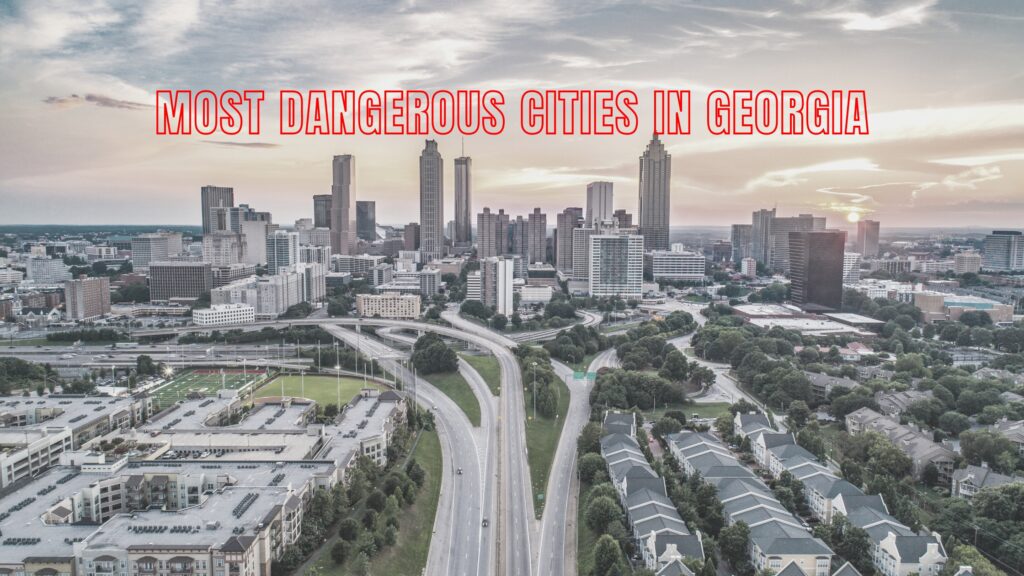Georgia is home to many thriving communities, but like any state, it has cities with higher crime rates than others. Based on crime data, including violent and property crimes, some cities consistently rank among the most dangerous in the state.
Key Takeaways:
- College Park has the highest violent crime rate in Georgia.
- East Point and Forest Park rank high for both violent and property crimes.
- Douglasville, Cordele, and Rome have significantly higher crime rates than state averages.
- Warner Robins and LaGrange report thousands of crimes annually.
- Griffin and Milledgeville stand out for crime levels relative to their population sizes.
The Most Dangerous Cities in Georgia
- College Park – The city with the highest violent crime rate in Georgia, standing at 7,909 per 100,000 residents. Property crime is also significantly high.
- East Point – Crime rate is 465% higher than the national average. Residents have a 1 in 10 chance of being a victim.
- Forest Park – Violent and property crimes exceed national averages by 143% and 147%, respectively.
- Douglasville – The crime rate is 140% higher than the state average, with a 1 in 18 chance of being a crime victim.
- Griffin – High crime levels compared to its population size.
- Cordele – Crime rate 133% above Georgia’s average.
- Rome – Residents face a 1 in 101 chance of falling victim to crime.
- Warner Robins – Over 3,606 reported crimes annually.
- LaGrange – Elevated crime rates in both violent and property categories.
- Milledgeville – A smaller city with disproportionately high crime levels.

Understanding Georgia’s Crime Landscape
1. College Park: The Epicenter of Crime
College Park holds the top spot for crime rates in Georgia. With a violent crime rate of 7,909 per 100,000 people, residents face a heightened risk of violent offenses, including robbery and aggravated assault. Property crimes also plague the city, making security a top concern for homeowners.
2. East Point: A Crime Hotspot
With crime rates 465% above the national average, East Point has a staggering rate of both violent and property crimes. This means that 1 in 10 residents is likely to be a victim, making it one of Georgia’s riskiest places to live.
3. Forest Park: A Struggle with Crime
Forest Park’s crime rate exceeds national averages by over 140%. Theft, burglary, and assault are major concerns, making it a high-risk area.
4. Douglasville: Crime on the Rise
Residents here have a 1 in 18 chance of falling victim to crime. The city has witnessed an increase in violent crimes, particularly in recent years.
5. Griffin & Cordele: Small Cities, Big Crime Problems
Though smaller in population, both Griffin and Cordele experience high crime rates. Cordele’s crime levels are 133% above Georgia’s average, making it a challenging place for law enforcement.
6. Rome & Warner Robins: High Crime Numbers
Rome has a high total crime rate, and Warner Robins reports over 3,600 crimes annually, making both cities among the riskiest in Georgia.
7. LaGrange & Milledgeville: Small but Dangerous
Despite their size, both LaGrange and Milledgeville struggle with crime, with rates surpassing other Georgia cities.
Additional Facts About Georgia’s Crime Rates
- Property crimes make up most offenses – Theft, burglary, and auto theft are common.
- Atlanta, despite its size, does not top the list – Though large, its crime rates do not exceed those of College Park or East Point.
- Smaller cities are not always safer – Many of Georgia’s most dangerous places are smaller towns rather than large metropolitan areas.
- Community policing helps – Some cities have adopted better policing strategies to curb crime rates.
Frequently Asked Questions
What is the most dangerous city in Georgia?
College Park ranks as the most dangerous city, with the highest violent crime rate in the state.
Why is East Point so dangerous?
East Point’s crime rate is significantly higher than the national average, with residents facing a 1 in 10 chance of being a victim.
Is Atlanta safer than these cities?
Yes. While Atlanta has crime issues, its overall crime rate is lower than cities like College Park and East Point.
What city in Georgia has the highest property crime rate?
College Park and Forest Park report some of the highest property crime rates in the state.
Are smaller towns in Georgia safer?
Not always. Many small cities, such as Cordele and Milledgeville, have crime rates higher than state averages.
Final Thoughts: Staying Safe in Georgia
While Georgia is home to many wonderful communities, some cities face significant crime challenges. Knowing where crime rates are high can help residents and visitors take precautions. Whether living in or traveling through these areas, staying informed and practicing safety measures can make a difference.
If you need added protection, consider getting a home security system. Contact us today at Callaway Security™. We’re just a call away!












